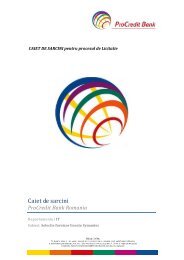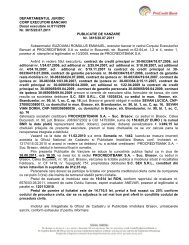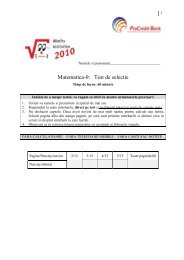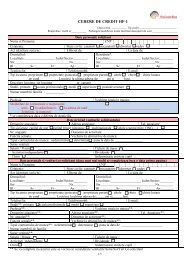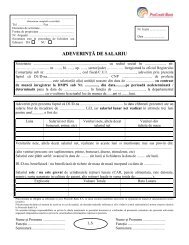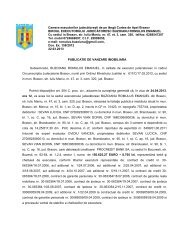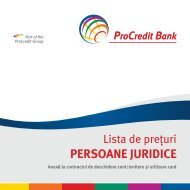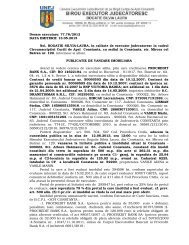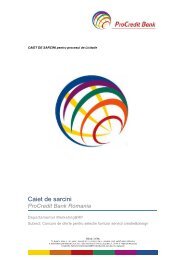Annual Report 2010 - ProCredit Bank
Annual Report 2010 - ProCredit Bank
Annual Report 2010 - ProCredit Bank
You also want an ePaper? Increase the reach of your titles
YUMPU automatically turns print PDFs into web optimized ePapers that Google loves.
In assessing collective impairment the <strong>Bank</strong> uses statistical modelling<br />
of historical trends of the probability of default, timing of recoveries<br />
and the amount of loss incurred, adjusted for management’s<br />
judgement as to whether current economic and credit conditions<br />
are such that the actual losses are likely to be greater or less than<br />
suggested by historical modelling. Default rates, loss rates and the<br />
expected timing of future recoveries are regularly benchmarked<br />
against actual outcomes to ensure that they remain appropriate.<br />
When a subsequent event causes the amount of impairment loss<br />
to decrease, the impairment loss is reversed through profit or loss.<br />
Impairment losses on available-for-sale investment securities are<br />
recognised by transferring the difference between the amortised<br />
acquisition cost and current fair value out of equity to profit or loss.<br />
When a subsequent event causes the amount of impairment loss<br />
on an available-for-sale debt security to decrease, the impairment<br />
loss is reversed through profit or loss.<br />
However, any subsequent recovery in the fair value of an impaired<br />
available-for-sale equity security is recognised directly in equity.<br />
Changes in impairment provisions attributable to time value are reflected<br />
as a component of interest income.<br />
If there is objective evidence that an impairment loss has been incurred<br />
on an unquoted equity instrument that is not carried at fair<br />
value because its fair value cannot be reliably measured, or on a<br />
derivative asset that is linked to and must be settled by delivery of<br />
such an unquoted equity instrument, the amount of the impairment<br />
loss is measured as the difference between the carrying amount of<br />
the financial asset and the present value of estimated future cash<br />
flows discounted at the current market rate of return for a similar<br />
financial asset. Such impairment losses shall not be reversed.<br />
i) Cash and cash equivalents<br />
Cash and cash equivalents comprise cash balances on hand, balances<br />
held with National <strong>Bank</strong> of Romania without minimum reserve<br />
and cash balances in ATM.<br />
For the purposes of the statement of cash flows, cash and cash<br />
equivalents include cash balances on hand, unrestricted balances<br />
held with central bank, and cash balances in ATM, current accounts<br />
with banks and placements with other banks with less than 90 days<br />
original maturity and are used by the <strong>Bank</strong> in the management of its<br />
short-term commitments.<br />
Cash and cash equivalents are carried at amortised cost in the balance<br />
sheet.<br />
j) Property and equipment<br />
i. Recognition and measurement<br />
Items of property and equipment are measured at cost less accumulated<br />
depreciation and impairment losses (refer to accounting<br />
policy no. 3.l).<br />
Cost includes expenditures that are directly attributable to the acquisition<br />
of the asset. The cost of self-constructed assets includes<br />
the cost of materials and direct labor, any other costs directly attributable<br />
to bringing the asset to a working condition for its intended<br />
use, and the costs of dismantling and removing the items<br />
and restoring the site on which they are located.<br />
When parts of an item of property or equipment have different useful<br />
lives, they are accounted for as separate items (major components)<br />
of property and equipment.<br />
ii. Subsequent costs<br />
The cost of replacing part of an item of property or equipment is<br />
recognised in the carrying amount of the item if it is probable that<br />
the future economic benefits embodied within the part will flow to<br />
the <strong>Bank</strong> and its cost can be measured reliably. The costs of the<br />
day-to-day servicing of property and equipment are recognised in<br />
profit or loss as incurred.<br />
iii. Depreciation<br />
Depreciation is recognised in profit or loss on a straight-line basis<br />
over the estimated useful lives of each part of an item of property<br />
and equipment. Leased assets are depreciated over the shorter of<br />
the lease term and their useful lives. Land is not depreciated.<br />
The estimated useful lives for the current and comparative year are<br />
as follows:<br />
Buildings 40 years<br />
Leasehold improvements 5 – 10 years<br />
Furniture and equipment 3 – 12 years<br />
Motor vehicles 5 years<br />
Depreciation methods, useful lives and residual values are reassessed<br />
at the reporting date.<br />
k) Intangible assets<br />
Software acquired by the <strong>Bank</strong> is stated at cost less accumulated<br />
amortisation and accumulated impairment losses (refer to accounting<br />
policy no. 3.l).<br />
Expenditure on internally developed software is recognised as an<br />
asset when the <strong>Bank</strong> is able to demonstrate its intention and ability<br />
to complete the development and use the software in a manner that<br />
will generate future economic benefits, and can reliably measure<br />
the costs to complete the development.<br />
The capitalised costs of internally developed software include all<br />
costs directly attributable to developing the software, and are amortised<br />
over its useful life. Internally developed software is stated<br />
at capitalised cost less accumulated amortisation and impairment.<br />
Subsequent expenditure on software assets is capitalised only<br />
when it increases the future economic benefits embodied in the<br />
specific asset to which it relates. All other expenditure is expensed<br />
as incurred.<br />
Amortisation is recognised in profit or loss on a straight-line basis<br />
over the estimated useful life of the software, from the date<br />
that it is available for use. The estimate useful life of software is<br />
three years.<br />
l) Impairment of non-financial assets<br />
Financial Statements 55<br />
The carrying amounts of the <strong>Bank</strong>’s non-financial assets, other<br />
than deferred tax assets, are reviewed at each reporting date to determine<br />
whether there is any indication of impairment. If any such<br />
indication exists then the asset’s recoverable amount is estimated.<br />
An impairment loss is recognised if the carrying amounts of an asset<br />
or its cash-generating unit exceed its recoverable amount. A<br />
cash-generating unit is the smallest identifiable asset group that<br />
generates cash flows that largely are independent from other assets<br />
and groups. Impairment losses are recognised in profit or loss.<br />
The recoverable amount of an asset or cash-generating unit is the<br />
greater of its value in use and its fair value less costs to sell. In assessing<br />
value in use, the estimated future cash flows are discounted<br />
to their present value using a pre-tax discount rate that reflects<br />
current market assessments of the time value of money and the<br />
risks specific to the asset. Impairment losses recognised in prior<br />
periods are assessed at each reporting date for any indications that<br />
the loss has decreased or no longer exists. An impairment loss is<br />
reversed if there has been a change in the estimates used to determine<br />
the recoverable amount. An impairment loss is reversed only<br />
to the extent that the asset’s carrying amount does not exceed the




